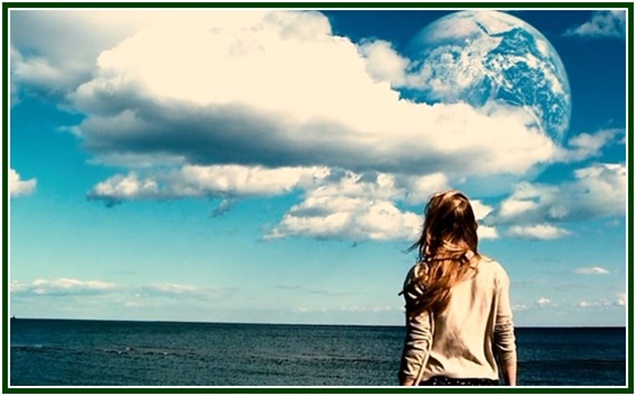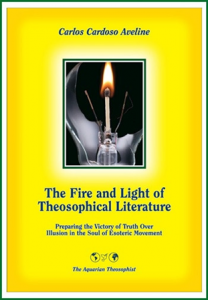
There Is No Separation Between
One’s Inner Life and the External Universe
Carlos Cardoso Aveline

One of the central tenets in classical theosophy refers to the correspondence between the external or objective world and the inner, subjective one.
In accordance with this principle, it is not correct to say that some topics are “spiritual” (as meditation and devotion, for instance) and other subjects are “non-spiritual”, like social justice, environmental protection or ethics in public life. There are, instead, some spiritual ways to look at all aspects of life; and other ways of looking at anything which are not spiritual.
According to Brazilian poet Mário Quintana (1906-1994), it is wrong to think that “some topics are poetical, and some are not”. There are points of view that are poetical, and other viewpoints that are not. Poetry, like spirituality, is more in one’s way of looking than in the things one looks at.
Although much depends on the point of view we adopt to look at life, it is also true that we must avoid naïve idealizations. Our critical thinking and courage to question must be preserved. The absence of change and of movement is the same as death. There’s a long evolution ahead and the world around us, just like ourselves, is far away from anything similar to perfection.
A spiritual way of looking at life must include therefore a certain rigor and an effort toward a noble goal. Perfection is not expected; however, both life and the law of karma require constant improvement.
When the truth-seeker understands the principle of dynamic correspondence between the inner and outer factors of life, he perceives that the point from which he looks at the universe is determined by the way his soul organizes itself. He recognizes the external world as an expression of his own state of mind and a mirror to the situation of his soul.
And yet, this is not enough.
The learner must take into consideration that the reverse is also true. His state of mind in part reflects the facts in the world around. The psychological layer of the universe has a level of consciousness which records and preserves the representation of external facts, and adapts itself to them. The Yoga Aphorisms of Patanjali teach that “the mind adopts the form of that which it observes” (Sutras I-04, II-11 and others).
Thanks to this two-way communication, there can be no separation between the external world and the internal realms of life. Although they are distinctly different from one another, they inevitably interact all the time.
Self-knowledge is necessary to understand the universe. And by studying the universe we expand the knowledge of ourselves. This is the reason why the mystic treaty “Light on the Path” makes the following recommendations to those who seek for truth:
* “Seek out the way.”
* “Seek the way by retreating within.”
* “Seek the way by advancing boldly without.” [1]
It is due to the principle of dynamic communication between the inner and outer worlds in one’s soul and in one’s individual aura that the original theosophy examines both “objective” and “subjective” aspects of life, and discusses topics like honesty in public life, nature preservation, ethics in the theosophical movement, reforestation, divine wisdom, esoteric philosophy, religions, and compared philosophies.
While we examine so many themes, which appear to point to different directions, we must investigate how to avoid mental dispersion. Our duty is not to automatically eliminate certain topics, labeling them as non-spiritual. The right thing to do is to pay attention and to preserve detachment as to the facts observed, and then identify the essential patterns underlying them all. The inner and noble substance of every field of knowledge is the same.
As we learn to grasp the essence of things, we can have a wide view of life, and keep free from mental dispersion.
The student who has a deep view of reality transcends superficial concepts like “inner” and “outer”, and achieves peace and silence without the childish illusion of denying life’s diversity. This is possible by looking at everything from the point of view of the individual’s heart, which is inseparable from the law of the universe. In the September 1974 edition of “Theosophy” magazine, one can see this question:
“How does study of what is ‘out there’ contribute to knowledge of the Self, which is obviously a very internal matter?”
And an anonymous student of esoteric philosophy answered:
“Ultimately, ‘within’ and ‘out there’ are both figures of speech, since the Self has no location, except relative to the physical conditions of our embodied existence, which appear to us as we perceive them with organs of sense. The Voice of the Silence instructs the disciple to ‘look inward: thou art Buddha’, but this ‘inward’ implies a stand to be taken by the learner. He is to seek for the moving principles in all things. These, being universal, are not the changing aspect of events, but those meanings which persist and continue to apply to other and higher forms and relationships.”
The “Theosophy” text goes on:
“For example, the principles relevant in a mathematical problem do not apply alone to that particular problem. The repeated discovery of this fact confers a synthesizing kind of knowledge – a realization of unity within diversity. Similarly, we discover that the inner self of man, in all its varied disguises, is not separate from the nature we perceive as ‘out there’. Man’s links, even identity, with the moving spirit of nature can be comprehended through the capacity of the self-conscious mind to recognize and know itself. This is the province of the mind as it functions in man, as a part of nature. Many of the forces which comprise human nature correspond to what is going on ‘out there’ – the seasonal cycles of growth, the storms, the adjustments and readjustments, some gradual, some cataclysmic, all containing in their completeness the full expression of the nature of the cause. H.P.B. notes in The Secret Doctrine the remarkable consistency with which events occur in cycles of seven in both nature and man. [2] But where, in nature, are the distinctively human powers? The power of choice, of initiative, of ideation? These include the power, not only to know, to do, to be, but also to reflect on the significance of all these acts – their implications, their effects – on all planes. In this capacity lies the power to identify with the whole universe, and yet ‘remain separate’ – to realize that the self is neither within nor without, not in any place, but in all places. The full development of this power in man is the capacity to ‘act for and as the Self of all creatures’. It is the attainment of those perfected men known as the Masters of Wisdom, the elder Brothers of humanity, who are not separate from nature but are its most fully self-conscious embodiment. Those who try to live in this way identify themselves to that extent with this side of nature and become knowers of both themselves and it.” (pp. 341-342)
An understanding of these facts emerges naturally as long as there is personal detachment and a growing width of horizons.
NOTES:
[1] Rules I-17 to I-19 in “Light on the Path”, by M.C., Theosophy Company, India. See pp. 4-5.
[2] “The Secret Doctrine”, H. P. Blavatsky, Theosophy Co., Los Angeles, vol. I, p. 586; vol. II, pp. 622-623.
000
The above article was first published at the June 2015 edition of “The Aquarian Theosophist” (pp. 2-5), with no indication as to the name of the author. The text is a translation from the Portuguese language article “O Mundo Como Espelho da Alma”, by CCA.
000
On the role of the esoteric movement in the ethical awakening of mankind during the 21st century, see the book “The Fire and Light of Theosophical Literature”, by Carlos Cardoso Aveline.

Published in 2013 by The Aquarian Theosophist, the volume has 255 pages and can be obtained through Amazon Books.
000